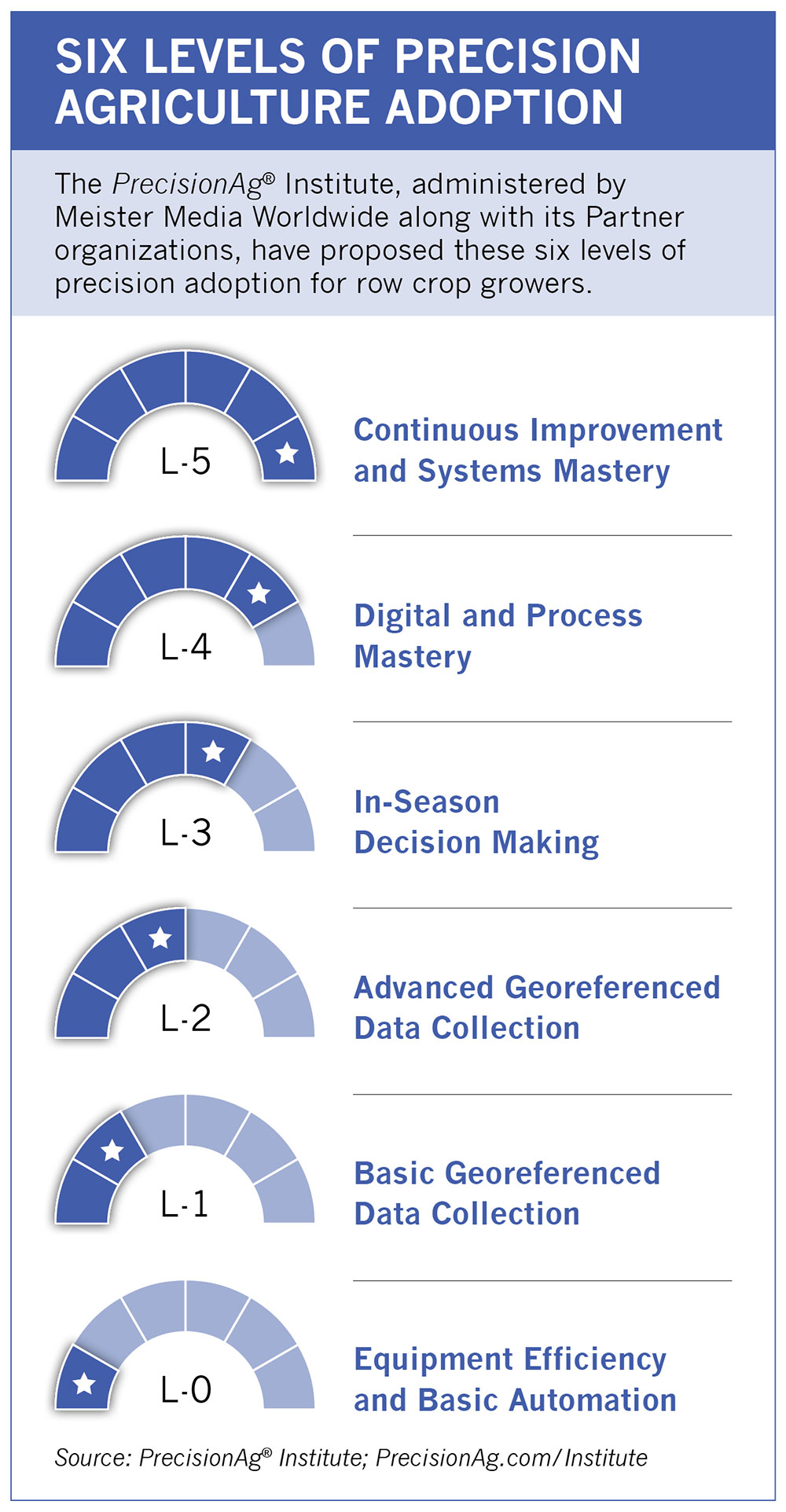Debate over technology adoption levels has roiled the precision agriculture industry for years. Is technology use increasing? Plateauing? Can we expect precision use to mainstream any time soon? Questions like these ultimately lead to an even bigger one: How is “adoption” defined in the first place? Which is to say: How do growers know when they’re “there”?
The PrecisionAg® Alliance, administered by Meister Media Worldwide along with representatives from its Partner organizations, took on this question and came to an agreement that the answer is likely not binary, that there is no clear divide of precision growers on one side and non-precision growers on the other. Rather, precision adoption is best represented on a sliding scale.
After considerable discussion about adoption specifically in row crops, consensus gelled around six core levels of adoption ranging from “basic” to “mastery.” Using these criteria, current and future adoption levels could be quantified more consistently and effectively.
Level 0: Equipment Efficiency and Basic Automation. At this level farmers are focused on efficiency technologies such as automation steering and boom shutoff. There is little to no data collected – or if data is collected, it is related to operational efficiency and not integrated into the production planning regimen.
Level 1: Basic Georeferenced Data Collection. Here, growers are collecting at least one layer of spatial data utilizing GPS, most likely through some kind of nutrient management system/regimen. The data enables them to make inter-field, or sub-field, assessments, as well as year-over-year fertility plans. Field imagery is collected and analyzed but not necessarily integrated fully into decision making. GPS resolution, at a minimum, is assisted by the Wide Area Augmentation System (WAAS).
 Level 2: Advanced Georeferenced Data Collection. Building on level 1, the grower collects data on additional layers for comparison to make operational decisions, which could include calibrated yield data, seed hybrid/variety information, in-season imagery, weather data, and other information sources. An outside agronomic service provider is often employed to help with collection and aggregation of data. The minimum GPS resolution is at the decimeter level.
Level 2: Advanced Georeferenced Data Collection. Building on level 1, the grower collects data on additional layers for comparison to make operational decisions, which could include calibrated yield data, seed hybrid/variety information, in-season imagery, weather data, and other information sources. An outside agronomic service provider is often employed to help with collection and aggregation of data. The minimum GPS resolution is at the decimeter level.
Level 3: In-Season Decision Making. Building on the minimum standards at Levels 1 and 2, growers are able to make, measure, and manage crop production using an evidence-based approach through the integration of multiple data layers. Growers at this level would be collecting as-applied records for all field operations – as-planted, as-fertilized, as-sprayed, and-as-scouted (including human and satellite/aerial observations) – and would create additional data layers to deepen field knowledge and understanding and improve decision making. Value generation from data should be such that a loss of data is viewed as potentially catastrophic to the farm – sufficient to halt farming operations for the sake of valid data collection. Either a trusted agronomic advisor or “in-house” agronomist will play an important leadership role in moving the use of precision technology and practices forward.
Level 4: Digital and Process Mastery. Having operated at Level 3 effectively for about three years, a Level 4 grower now possesses multiple data layers over multiple years, affording the ability to make comparisons year over year, as well as in season, to make on-the-go operational decisions. Trusted adviser(s) and commercial partners usually play a significant role in helping the farmer move into this level.
Level 5: Continuous Improvement and Systems Mastery. This final and highest level builds upon Level 4 effectiveness in the creation and use of valid data sets, and confidence in continuous improvement, by pushing into exploration of technologies and systems that allow for targeted, effective decision making on a continuous basis – for instance, nitrogen management modeling for targeted split applications, on-the-go sensors, use of weather and soil moisture sensors, insect and disease pressure monitoring, and imagery collection and use. Regardless of the field or crop situation, the farmer is fully informed and in control of decision making. Further, at this advanced level growers can more effectively engage with the downstream food production channel on sustainability and value-add crop production regimens.
What is effective and potentially durable about this five-level adoption scale is that it’s less reliant on specific but evolving technologies and more on timeless and enduring agricultural practices – especially observation, analysis, and decision making in the areas of fertility, planting, application, and harvest. The Institute and its Partners do acknowledge, however, that the criteria still can be fine-tuned – for example, perhaps by adding a level at both the lowest and highest levels of adoption.
Comments and questions about the five levels of precision adoption are encouraged and can be directed to Paul Schrimpf, PrecisionAg Alliance, at pschrimpf@meistermedia.com, 440-602-9142.
